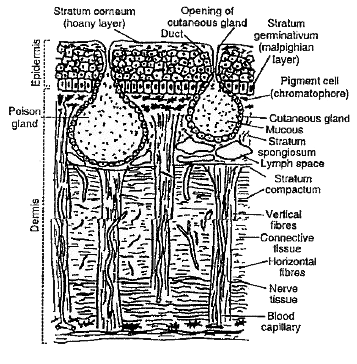Describe the structure of integument of frog.
Text Solution
Structure of the skin of frog. The skin of frog is thin, smooth, slimy, moist, scaleless and is loosely attached to the underlying muscles by connective tissue fibres. It is thicker on the dorsal side than on the ventral side. The colour of the skin on the dorsal .side is dark green with black patches while on the ventral side it is pale yellow.
Internal structure of skin. Histologically the skin of frog is composed of two distinct layers :
1. Epidermis
2. Dermis
I. Epidermis. It is the outer, non-vascular and stratified layer which is composed of three layers:
(i) Horny layer: The protoplasm changes into a horny substance, the keratin which forms the dead layer of horny material. The horny layer is periodically cast off in small fragments.
The keratin is insoluble in water and protects the body against excessive loss of water.
(ii) Stratum corneum. The cells of the stratum corneum are flat and are pushed to the outer surface.
(iii) Stratum malpigii. The stratum malpigii or stratum germinativum is the innermost layer of columnar cells which divide mitotically and produce new cells of the stratum corneum basement membrane. Over the eyes, the :Pidermis forms transparent vascular corijuctiva.
Below the stratum malpighi, there are large number of pigment cells or chromatophores which are abundant on the dorsal side. These impart the colour of the skin. The changes in colour are produced by expansion in the cells and are under the control of pituitary hormone.
2. Dermis. The innerlayer is the dermis which is composed ofnetwork of connective tissue lying in vertical and horizontal position. It also contains blood capillaries, nerve fibres and chromatophores. The dermis is divisible into two layers : an outer stratum spongiosum and an inner stratum compactum. The stratum spongiosum is made up of loose fibrous connective tissue, lymph spaces and large number of simple alveolar glands. These cutaneous glands are of two types : the mucous glands. and the poisonous glands. Tile mucous glands are flask shaped and open outside by pores on the epidermis. These are numerous and are uniformly distributed all over the body. The mucous glands produce a slippery mucus which moistens and lubricates the skin. The poisonous glands are large, flask shaped but with thin walls. They produce a poisonous fluid which protects the animal from its carnivorous enemies. Poison glands are developed in toad, Buja as parotoid glands behind the tympanum. Though the glands lie in dermis butthese are the derivatives of the epidermis.
The stratum compactum is made up ofnet work of dense collagen fibres of parallel nature, smooth muscle fibres, nerve fibres and blood capillaries. Below the dermis there is a loose layer of connective tissue, the sub-cutaneous tissue.

|
Similar Questions
Knowledge Check
Which one is present in integument of Frog but not in mammals ?
ASweat glandsBDermisCStratum germinativumDMucous glandsWhich one of the following is present in the integument of frog but not in that of mammals ?
ADermisBMucous glandCSweat glandsDStratum germinativumThe structure formed by outer integument which helps in germination of seed in castor is called:
AArilBSarcotestaCCaruncleDOperculum
Describe the reproductive organs of female frog.
View SolutionDescribe the manus or pes of frog.
View SolutionGive three structural differences between a frog and a lizard.
View SolutionDescribe the digestive system of frog.
View SolutionWhich one is present in integument of Frog but not in mammals ?
(a) Sweat glands
(b) Dermis
(c) Stratum germinativum
(d) Mucous glands
View Solution
